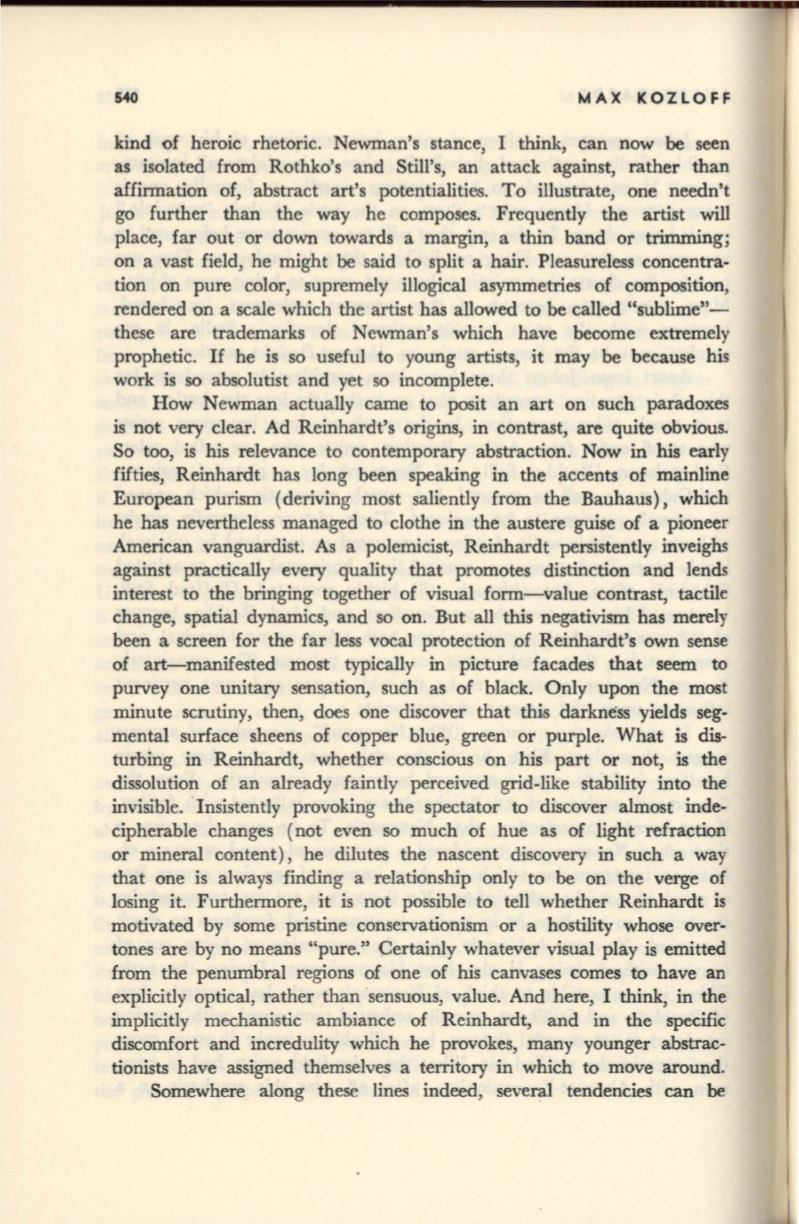

540
MAX KOZLOFF
kind of heroic rhetoric. Newman's stance, I think, can now
be
seen
as isolated from Rothko's and StilI's, an attack against, rather than
affirmation of, abstract art's potentialities. To illustrate, one needn't
go further than the way he composes. Frequently the artist will
place, far out or down towards a margin, a thin band or trimming;
on a vast field, he might
be
said to split a hair. Pleasureless concentra–
tion on pure color, supremely illogical asymmetries of composition,
rendered on a scale which the artist has allowed to be called "sublime"–
these are trademarks of Newman's which have become extremely
prophetic.
If
he is so useful to young artists, it may be because his
work is so absolutist and yet so incomplete.
How Newman actually came to posit an art on such paradoxes
is not very clear. Ad Reinhardt's origins, in contrast, are quite obvious.
So too, is his relevance to contemporary abstraction. Now in his early
fifties, Reinhardt has long been speaking in the accents of mainline
European purism (deriving most saliently from the Bauhaus), which
he has nevertheless managed to clothe in the austere guise of a pioneer
American vanguardist. As a polemicist, Reinhardt persistently inveighs
against practically every quality that promotes distinction and lends
interest to the bringing together of visual form-value contrast, tactile
change, spatial dynamics, and so on. But all this negativism has merely
been a screen for the far less vocal protection of Reinhardt's own sense
of art-manifested most typically in picture facades that seem to
purvey one unitary sensation, such as of black. Only upon the most
minute scrutiny, then, does one discover that this darkness yields seg–
mental surface sheens of copper blue, green or purple. What is dis–
turbing in Reinhardt, whether conscious on his part or not, is the
dissolution of an already faintly perceived grid-like stability into the
invisible. Insistently provoking the spectator to discover almost inde–
cipherable changes (not even so much of hue as of light refraction
or mineral content), he dilutes the nascent discovery in such a way
that one is always finding a relationship only to be on the verge of
losing it. Furthermore, it is not possible to tell whether Reinhardt is
motivated by some pristine conservationism or a hostility whose over–
tones are by no means "pure." Oertainly whatever visual play is emitted
from the penumbral regions of one of his canvases comes to have an
explicitly optical, rather than sensuous, value. And here, I think, in the
implicitly mechanistic ambiance of Reinhardt, and in the specific
discomfort and incredulity which he provokes, many younger abstrac–
tionists have assigned themselves a territory in which to move around.
Somewhere along these lines indeed, several tendencies can
be









